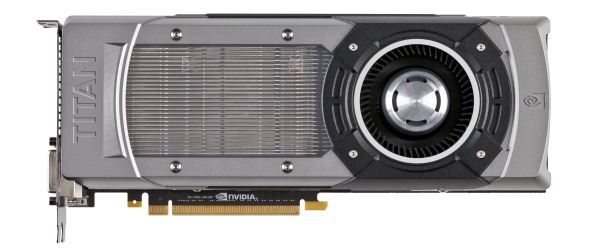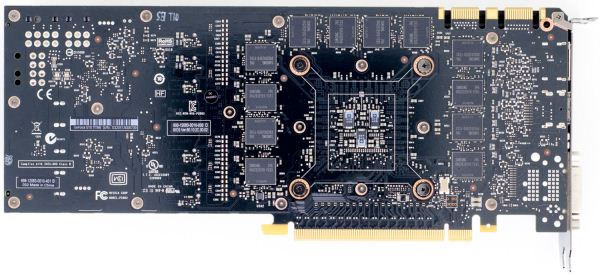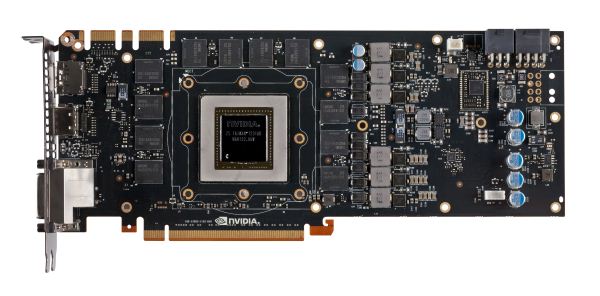NVIDIA's GeForce GTX Titan, Part 1: Titan For Gaming, Titan For Compute
by Ryan Smith on February 19, 2013 9:01 AM ESTMeet The GeForce GTX Titan
As we briefly mentioned at the beginning of this article, the GeForce GTX Titan takes a large number of cues from the GTX 690. Chief among these is that it’s a luxury card, and as such is built to similar standards as the GTX 690. Consequently, like the GTX 690, Titan is essentially in a league of its own when it comes to build quality.
Much like the GTX 690 was to the GTX 590, Titan is an evolution of the cooler found on the GTX 580. This means we’re looking at a card roughly 10.5” in length using a double-wide cooler. The basis of Titan’s cooler is a radial fan (blower) sitting towards the back of the card, with the GPU, RAM, and most of the power regulation circuitry in front of the fan. As a result the bulk of the hot air generated by Titan is blown forwards and out of the card. However it’s worth noting that unlike most other blowers technically the back side isn’t sealed, and while there is relatively little circuitry behind the fan, it would be incorrect to state that the card is fully exhausting. With that said, leaving the back side of the card open seems to be more about noise and aesthetics than it does heat management.
Like the GTX 580 but unlike the GTX 680, heat transfer is provided by a nickel tipped aluminum heatsink attached to the GPU via a vapor chamber. We typically only see vapor chambers on premium cards due to their greater costs, but also when space is at a premium. Meanwhile NVIDIA seems to be pushing the limits of heatsink size here, with the fins on Titan’s heatsink actually running beyond the base of the vapor chamber. Meanwhile providing the thermal interface between the GPU itself and the vapor chamber is a silk screened application of a high-end Shin-Etsu thermal compound; NVIDIA claims this compound offers over twice the performance of GTX 680’s grease, although of all of NVIDIA’s claims this is the least possible to validate.
Moving on, catching what the vapor chamber doesn’t cover is an aluminum baseplate that runs along the card, not only providing structural rigidity but also providing cooling for the VRMs and for the RAM on the front side of the card. Baseplates aren’t anything new for NVIDIA, but again this is something that we don’t see a lot of except on their more premium cards.
Capping off Titan we have its most visible luxury aspects. Like the GTX 690 before it, NVIDIA has replaced virtually every bit of plastic with metal for aesthetic/perceptual purposes. This time the entire shroud and fan housing is composed of casted aluminum, which NVIDIA tells us is easier to cast than the previous mix of aluminum and magnesium that the GTX 690 used. Meanwhile the polycarbonate window makes its return allowing you to see Titan’s heatsink solely for the sake of it.
As for the back side of the card, keeping with most of NVIDIA’s cards Titan runs with a bare back. The GDDR5 RAM chips don’t require any kind of additional cooling, and a metal backplate while making for a great feeling card, occupies precious space that would otherwise impede cooling in tight spaces.
Moving on, let’s talk about the electrical details of Titan’s design. Whereas GTX 680 was a 4+2 power phase design – 4 power phases for the GPU and 2 for the VRAM – Titan improves on this by moving to a 6+2 power phase design. I suspect the most hardcore of overclockers will be disappointed with Titan only having 6 phases for the GPU, but for most overclocking purposes this would seem to be enough.
Meanwhile for RAM it should come as no particular surprise that NVIDIA is once more using 6GHz RAM here. Specifically, NVIDIA is using 24 6GHz Samsung 2Gb modules here, totaling up to the 6GB of RAM we see on the card. 12 modules are on front with the other 12 modules on the rear. The overclocking headroom on 6GHz RAM seems to vary from chip to chip, so while Titan should have some memory overclocking headroom it’s hard to say just what the combination of luck and the wider 384bit memory bus will do.
Providing power for all of this is a pair of PCIe power sockets, a 6pin and an 8pin, for a combined total of 300W of capacity. With Titan only having a TDP of 250W in the first place, this leaves quite a bit of headroom before ever needing to run outside of the PCIe specification.
At the other end of Titan we can see that NVIDIA has once again gone back to their “standard” port configuration for the GeForce 600 series: two DL-DVI ports, one HDMI port, and one full-size DisplayPort. Like the rest of the 600 family, Titan can drive up to four displays so this configuration is a good match. Though I would still like to see two mini-DisplayPorts in the place of the full size DisplayPort, in order to tap the greater functionality DisplayPort offers though its port conversion mechanisms.














157 Comments
View All Comments
hammer256 - Tuesday, February 19, 2013 - link
Ryan's analysis of the target market for this card is spot on: this card is for small scale HPC type workloads, where the researcher just want to build a desktop-like machine with a few of those cards. I know that's what I use for my research. To me, this is the real replacement of the GTX 580 for our purposes. The price hike is not great, but when put to context of the K20X, it's a bargain. I'm lusting to get 8 of these cards and get a Tyan GPU server.Gadgety - Tuesday, February 19, 2013 - link
While gamers see little benefit, it looks like this is the card for GPU rendering, provided the software developers at VRay, Octane and others find a way to tap into this. So one of these can replace the 3xGTX580 3GBs.chizow - Tuesday, February 19, 2013 - link
Nvidia has completely lost their minds. Throwing in a minor bone with the non-neutered DP performance does not give them license to charge $1K for this part, especially when DP on previous flagship parts carried similar performance relative to Tesla.First the $500 for a mid-range ASIC in GTX 680, then $1200 GTX 690 and now a $1000 GeForce Titan. Unbelievable. Best of luck Nvidia, good luck competing with the next-gen consoles at these price points, or even with yourselves next generation.
While AMD is still at fault in all of this for their ridiculous launch pricing for the 7970, these recent price missteps from Nvidia make that seem like a distant memory.
ronin22 - Wednesday, February 20, 2013 - link
Bullshit of a typical NV hater.The compute-side of the card isn't a minor bone, it's its prime feature, along with the single-chip GTX690-like performance.
"especially when DP on previous flagship parts carried similar performance relative to Tesla"
Bullshit again.
Give me a single card that is anywhere near the K20 in DP performance and we'll talk.
You don't understand the philosophy of this card, as many around here.
Thanksfully, the real intended audience is already recognizing the awesomeness of this card (read previous comments).
You can go back to playing BF3 on your 79xx, but please close the door behind you on your way out ;)
chizow - Wednesday, February 20, 2013 - link
Heh, your ignorant comments couldn't be further from the truth about being an "NV hater". I haven't bought an ATI/AMD card since the 9700pro (my gf made the mistake of buying a 5850 though, despite my input) and previously, I solely purchased *multiple* Nvidia cards in this flagship market for the last 3 generations.I have a vested interest in Nvidia in this respect as I enjoy their products, so I've never rooted for them to fail, until now. It's obvious to me now that between AMD's lackluster offerings and ridiculous launch prices along with Nvidia's greed with their last two high-end product launches (690 and Titan), that they've completely lost touch with their core customer base.
Also, before you comment ignorantly again, please look up the DP performance of GTX 280 and GTX 480/580 relative to their Tesla counterparts. You will see they are still respectable, ~1/8th of SP performance, which was still excellent compared to the completely neutered 1/32 DP of GK104 Kepler. That's why there is still a high demand for flagship Fermi parts and even GT200 despite their overall reputation as a less desirable part due to their thermal characteristics.
Lastly, I won't be playing BF3 on a 7970, try a pair of GTX 670s in SLI. There's a difference between supporting a company through sound purchasing decisions and stupidly pissing away $1K for something that cost $500-$650 in the past.
The philosophy of this card is simple: Rob stupid people of their money. I've seen enough of this in the past from the same target audience and generally that feeling of "awesomeness" is quickly replaced by buyer's remorse as they realize that slightly higher FPS number in the upper left of their screen isn't worth the massive number on their credit card statement.
CeriseCogburn - Sunday, February 24, 2013 - link
That one's been pissing acid since the 680 launch, failed and fails to recognize the superior leap of the GTX580 over the prior gen, which gave him his mental handicap believing he can get something for nothing, along with sucking down the master amd fanboy Charlie D's rumor about the "$350" flagship nVidia card blah blah blah 680 blah blah second tier blah blah blah.So instead the rager now claims he wasted near a grand on two 670's - R O F L - the lunatics never end here man.
bamboo69 - Tuesday, February 19, 2013 - link
Origin is using EK Waterblocks? i hope they arentt nickel plated, their nickel blocks flakeKnock24 - Wednesday, February 20, 2013 - link
I've seen it mentioned in the article that Titan has HyperQ support, but I've also read the opposite elsewhere.Can anyone confirm that HyperQ is supported? I'm guessing the simpleHyperQ Cuda SDK example might reveal if it's supported or not.
torchedguitar - Wednesday, February 20, 2013 - link
HyperQ actually means two separate things... One part is the ability to have a process act as a server, providing access to the GPU for other MPI processes. This is supported on Linux using Tesla cards (e.g. K20X) only, so it won't work on GTX Titan (it does work on Titan the supercomputer, though). The other part of HyperQ is that there are multiple hardware queues available for managing the work on multiple CUDA streams. GTX Titan DOES support this part, although I'm not sure just how many of these will be enabled (it's a tradeoff, having more hardware streams allows more flexibility in launching concurrent kernels, but also takes more memory and takes more time to initialize). The simpleHyperQ sample is a variation of the concurrentKernels sample (just look at the code), and it shows how having more hardware channels cuts down on false dependencies between kernels in different streams. You put things in different stream because they have no dependencies on each other, so in theory nothing in stream X should ever get stuck waiting for something in stream Y. When that does happen due to hitting limits of the hardware, it's a false dependency. An example would be when you try to time a kernel launch by wrapping it with CUDA event records (this is the simpleHyperQ sample). GPUs before GK110 only have one hardware stream, and if you take a program that launches kernels concurrently in separate streams, and wrap all the kernels with CUDA event records, you'll see that suddenly the kernels run one-at-a-time instead of all together. This is because in order to do the timing for the event, the single hardware channel queues up the other launches while waiting for each kernel to finish, then it records the end time in the event, then goes on to the next kernel. With HyperQ's addition of more hardware streams, you get around this problem. Run the simpleHyperQ sample on a 580 or a 680 through a tool like Nsight and look at the timeline... You'll see all the work in the streams show up like stair steps -- even though they're in different streams, they happen one at a time. Now run it on a GTX Titan or a K20 and you'll see many of the kernels are able to completely overlap. If 8 hardware streams are enabled, the app will finish 8x faster, or if 32 are enabled, 32x faster.Now, this sample is extremely contrived, just to illustrate the feature. In reality, overlapping kernels won't buy you much speedup if you're already launching big enough kernels to use the GPU effectively. In that case, there shouldn't much room left for overlapping kernels, except when you have unbalanced workloads where many threads in a kernel finish quickly but a few stragglers run way longer. With HyperQ, you greatly increase your chances that kernels in other streams can immediately start using the resources freed up when some of the threads in a kernel finish early, instead of waiting for all threads in the kernel to finish before starting the next kernel.
vacaloca - Monday, March 4, 2013 - link
I wanted to say that you hit the nail on the head... I just tested the simpleHyperQ example, and indeed, the Titan has 8 hardware streams enabled. For every multiple higher than 8, and the "Measured time for sample" goes up.